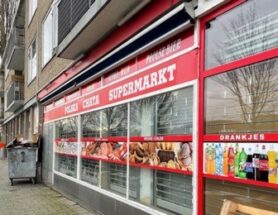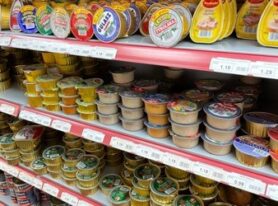News
Polish Foodscapes in Rotterdam: a taste of Daan van Berk’s BSc Research
What the Carnisse neighbourhood can teach us about the link between food practices and migration in Dutch cities
written by MIGFOODCITY student assistant Lucia Terzuolo
The Polish community represents the largest group of foreign immigrants in the Netherlands, with over 25,000 officially registered individuals in 2021 (Statista, 2022). Having noticed a concentration of Polish supermarkets in Rotterdam’s Carnisse neighbourhood, Human Geography student Daan van Berk used this as a window to study Polish foodscapes in the Dutch port city. Carrying out observational and qualitative research, Daan wrote his Human Geography BSc dissertation about the link between Rotterdam’s Polish population and Carnisse’s food environment.
Daan’s research findings

Entry of the Polska Chata Supermarket in Carnisse. Credits: Daan van Berk (2022)
The first fundamental finding Daan could gather from his interviews with
Carnisse’s Polish inhabitants concerns their dynamic relationship with food. The majority of them regularly goes to Polish supermarkets, but this appears to change depending on the amount of time they have resided in the neighbourhood. For people that had recently arrived and did not speak Dutch, Polish supermarkets were the go-to grocery shop, as this helped them feel welcomed in the neighbourhood, especially considering they often did not feel at home in the Netherlands. By contrast, the ones who felt more connected to the Dutch society would only go to Polish shops to buy specific culturally relevant goods. This shows that food plays an important role in how Polish immigrants navigate their (new) environments in their daily lives in the Netherlands. Additionally, another crucial finding in Daan’s research is that most Polish supermarkets are not owned by Polish but by Kurdish people, who saw an opportunity for business. They therefore sell Polish products but do not make the shops an active stronghold of Polish culture and identity.
Carnisse’s past and future
Carnisse’s past shows that it has long been the subject of migration flows. From Southern Dutch immigrants coming to work in the port of Rotterdam, to Polish people employed in the agricultural sector around the city, job opportunities have often been the motive behind such movements, making Carnisse a historical residential neighbourhood for the city’s working class. Daan’s research shows that the food practices in the neighbourhood have been strongly impacted by such flows, including in a physical way since the number of Polish supermarkets in Carnisse increased from 5 in 2017 to 14 in 2022. The neighbourhood’s foodscape is therefore to a large extent shaped by the immigrant groups inhabiting the neighbourhood to work.
However, this relationship between food and immigrant groups is complex and bound to change through time. Daan’s interview already unveiled how

Typical Polish products in a Polska Chata Supermarket in Carnisse.
Credits: Daan van Berk (2022)
economic factors are crucial in determining Carnisse’s Polish food habits. While until last year buying at Polish supermarkets was economically convenient, the invasion of Ukraine made prices of many Polish products dramatically increase, resulting in several regular customers to rely more on Dutch supermarkets. These fluctuations are likely going to remain in Carnisse’s dynamic foodscape in the future. In particular, gentrification will be an increasingly important factor in determining these developments. According to Daan, gentrification processes in the neighbourhood have had until now only limited consequences on the Polish immigrants’ food practices. However, he argues that such impacts will probably become more relevant as both housing and commercial gentrification are predicted to increase following restructuring plans by the municipality.
Recommendations for the MIGFOODCITY project
Daan’s research about the Polish foodscape in Rotterdam can bring valuable contributions to the MIGFOODCITY project in Utrecht, both methodologically and content-wise. Importantly, Daan’s research shows that Polish supermarkets in the neighbourhood do not necessarily become places of cultivation of the Polish identity, as most of them are not owned by Polish people. Moreover, the fact that Polish shops in Carnisse are often the business of its Kurdish community carries an important implication for the MIGFOODICTY project. Diverse immigrant groups use neighbourhoods in different ways, sometimes creating intricate interactions like between the Polish and Kurdish in Rotterdam. This is crucial to keep in mind while researching food practices in Utrecht’s Lombok, as differentiating per cultural group can illuminate key dynamics determining the neighbourhood’s foodscape.

